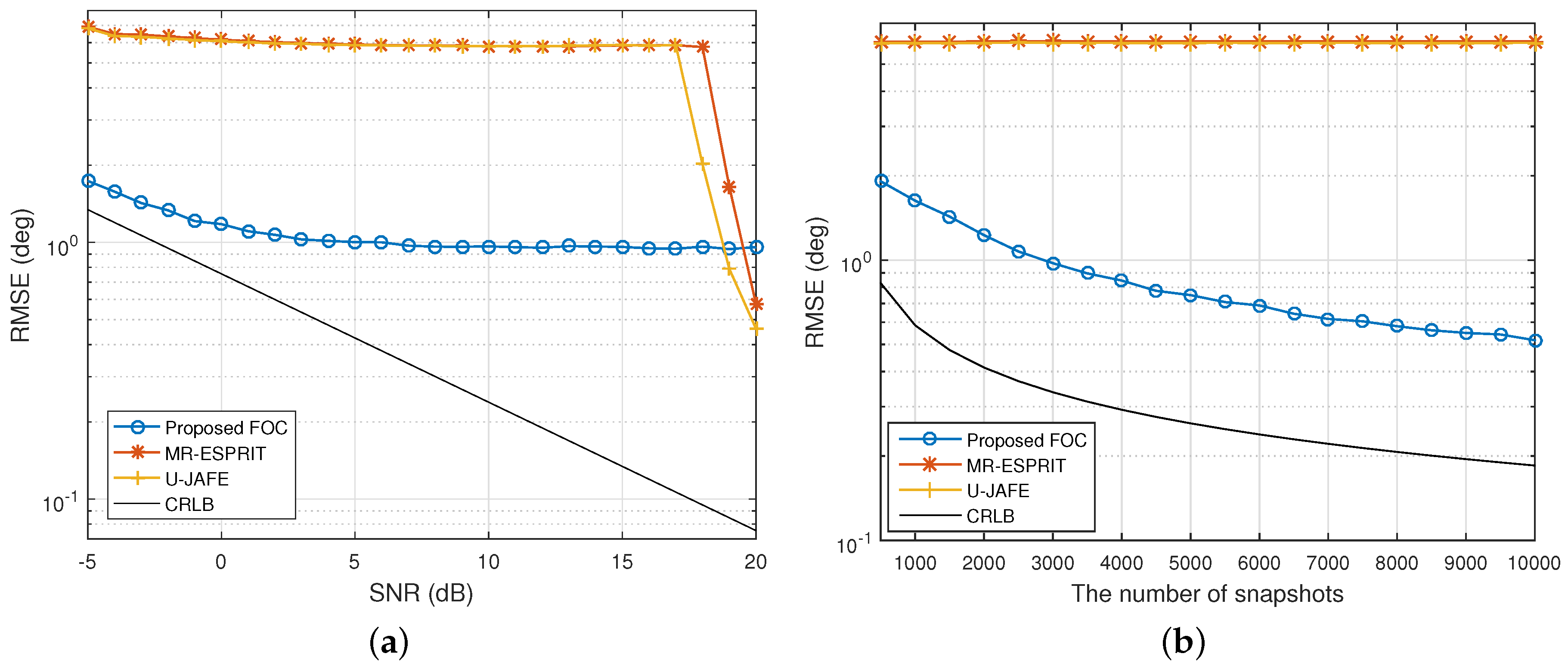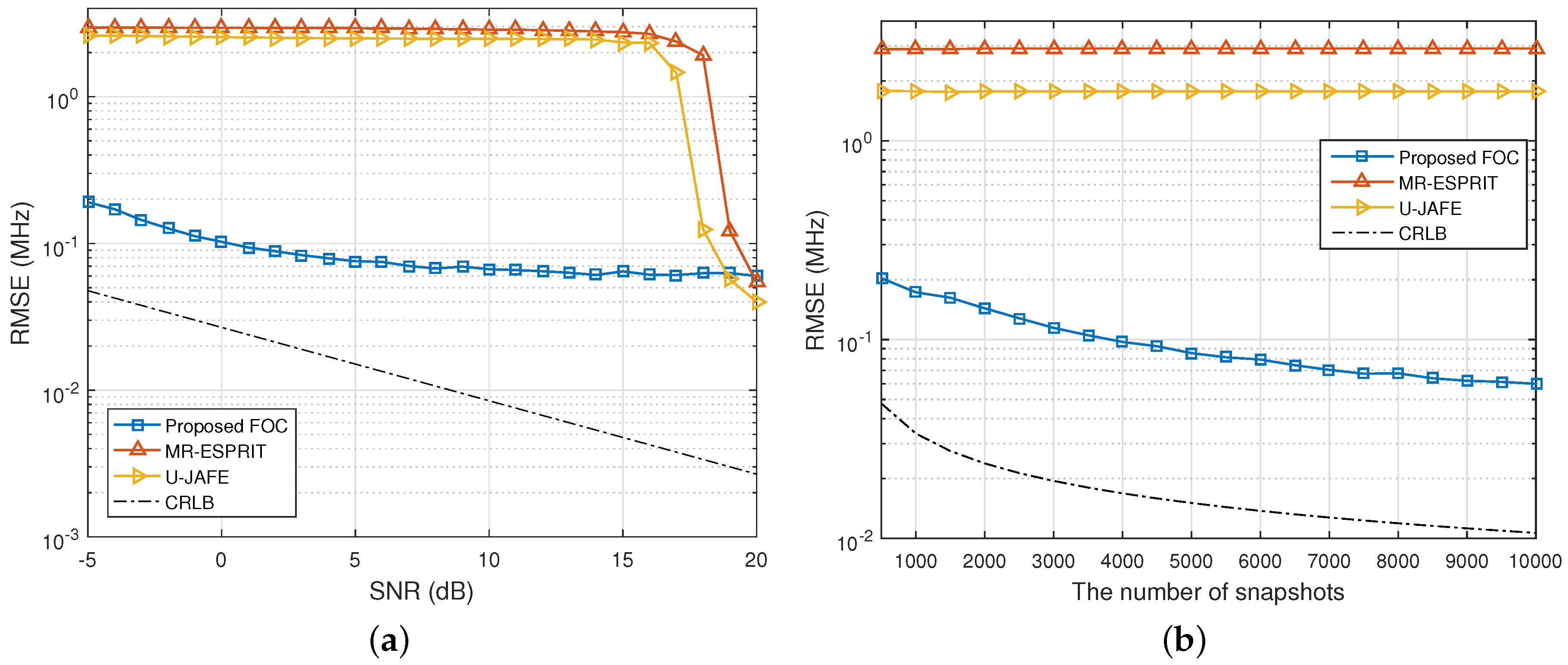Efficient Cumulant-Based Methods for Joint Angle and Frequency Estimation Using Spatial-Temporal Smoothing
Abstract
1. Introduction
- The most important difference is that the operation of FOC with respect to JAFE is developed for the first time, and the corresponding existence conditions, and the number of achieved DOFs is analysed accordingly.
- In [6,7,8,9,10,11], only the temporal and spatial white Gaussian noise is considered, while in this paper, we study the JAFE in a more general case, i.e., the temporal and spatial coloured Gaussian noise, and propose an FOC-based estimator to jointly determine DOA, as well as frequency robust to white or coloured noise.
- In [6,7,9], the number of coherent signals that can be dealt with is up to , where M is the number of array elements, which is a strict condition. In practice, one base station serves multiple users simultaneously, where the propagation from each user composes multipath, so the total number of coherent signals may exceed that of array elements. The approach developed in this paper is capable of handling such a tough challenge that cannot be overcome by the previous techniques.
- To reduce the cumbersome computations arising from the processing by FOC, we transform the complex-valued information to the field of real numbers and perform the resultant RARE estimator by solving the roots of a polynomial, avoiding the multidimensional search.
2. Problem Formulation
2.1. Signal Model
2.2. Temporal Smoothing
3. Proposed FOC-Based Joint Angle and Frequency Estimator
3.1. Independent Signals
3.2. Coherent Signals
4. Simulation Results and Discussion
4.1. JAFE of Independent Signals
4.2. JAFE of Coherent Signals
5. Conclusions
Author Contributions
Funding
Acknowledgments
Conflicts of Interest
References
- Djeddou, M.; Belouchrani, A.; Aouada, S. Maximum likelihood angle-frequency estimation in partially known correlated noise for low-elevation targets. IEEE Trans. Signal Process. 2005, 53, 3057–3064. [Google Scholar] [CrossRef]
- Wang, S.; Caffery, J.; Zhou, X. Analysis of a joint space-time DOA/FOA estimator using MUSIC. In Proceedings of the IEEE International Symposium on Personal, Indoor and Mobile Radio Communications (PIMRC 2001), San Diego, CA, USA, 30 September–3 October 2001; pp. 138–142. [Google Scholar]
- Lin, J.D.; Fang, W.H.; Wang, Y.-Y.; Chen, J.T. FSF MUSIC for joint DOA and frequency estimation and its performance analysis. IEEE Trans. Signal Process. 2006, 54, 4529–4542. [Google Scholar] [CrossRef]
- Zoltowski, M.D.; Mathews, C.P. Real-time frequency and 2-D angle estimation with sub-Nyquist spatio-temporal sampling. IEEE Trans. Signal Process. 1994, 42, 2781–2794. [Google Scholar] [CrossRef]
- Haardt, M.; Nossek, J.A. 3-D unitary ESPRIT for joint 2-D angle and carrier estimation. In Proceedings of the 1997 IEEE International Conference on Acoustics, Speech, and Signal Processing (ICASSP), Munich, Germany, 21–24 April 1997; pp. 255–258. [Google Scholar]
- Lemma, A.N.; van der Veen, A.J.; Deprettere, E.F. Joint angle-frequency estimation using multi-resolution ESPRIT. In Proceedings of the IEEE International Conference on Acoustics, Speech and Signal Processing (ICASSP), Seattle, WA, USA, 15 May 1998; pp. 1957–1960. [Google Scholar]
- Lemma, A.N.; van der Veen, A.J.; Deprettere, E.F. Analysis of joint angle-frequency estimation using ESPRIT. IEEE Trans. Signal Process. 2003, 51, 1264–1283. [Google Scholar] [CrossRef]
- Zhang, X.; Feng, G.; Yu, J.; Xu, D. Angle-frequency estimation using trilinear decomposition of the oversampled output. Wirel. Pers. Commun. 2009, 51, 365–373. [Google Scholar]
- Liu, F.; Wang, J.; Du, R. Unitary-JAFE algorithm for joint angle-frequency estimation based on Frame-Newton method. Signal Process. 2010, 90, 809–820. [Google Scholar] [CrossRef]
- Kisliansky, A.; Shavit, R.; Member, S.; Tabrikian, J. Direction of arrival estimation in the presence of noise coupling in antenna arrays. IEEE Trans. Antennas Propag. 2007, 55, 1940–1947. [Google Scholar] [CrossRef]
- Niow, C.H.; Hui, H.T. Improved noise modeling with mutual coupling in receiving antenna arrays for direction-of-arrival estimation. IEEE Trans. Antennas Propag. 2012, 11, 1616–1621. [Google Scholar] [CrossRef]
- LeCadre, J. Parametric methods for spatial signal processing in the presence of unknown coloured noise fields. IEEE Trans. Acoust. Speech Signal Process. 1989, 37, 965–983. [Google Scholar] [CrossRef]
- Friedlander, B.; Weiss, A.J. Direction finding using noise covariance modeling. IEEE Trans. Signal Process. 1995, 43, 1557–1567. [Google Scholar] [CrossRef]
- Goransson, B.; Ottersten, B. Direction estimation in partially unknown noise fields. IEEE Trans. Signal Process. 1999, 47, 2375–2385. [Google Scholar] [CrossRef]
- Pesavento, M.; Gershman, A.B. Maximum-likelihood direction of arrival estimation in the presence of unknown nonuniform noise. IEEE Trans. Signal Process. 2001, 49, 1310–1324. [Google Scholar] [CrossRef]
- Vorobyov, S.A.; Gershman, A.B.; Wong, K.M. Maximum likelihood direction-of-arrival estimation in unknown noise fields using sparse sensor arrays. IEEE Trans. Signal Process. 2005, 53, 34–43. [Google Scholar] [CrossRef]
- Porat, B.; Friedlander, B. Direction finding algorithms based on high-order statistics. IEEE Trans. Signal Process. 1991, 39, 2016–2024. [Google Scholar] [CrossRef]
- Dǒgan, M.C.; Mendel, J.M. Applications of cumulants to array processing—Part I: Aperture extension and array calibration. IEEE Trans. Signal Process. 1995, 43, 1200–1216. [Google Scholar] [CrossRef]
- Chevalier, P.; Albera, L.; Ferreol, A.; Comon, P. On the virtual array concept for higher order array processing. IEEE Trans. Signal Process. 2005, 53, 1254–1271. [Google Scholar] [CrossRef]
- Wang, Y.; Trinkle, M.; Brian, B.W.H. Two-stage DOA estimation of independent and coherent signals in spatially coloured noise. Signal Process. 2016, 128, 350–359. [Google Scholar] [CrossRef]
- Yilmazer, N.; Koh, J.; Sarkar, T.K. Utilization of a unitary transform for efficient computation in the matrix pencil method to find the direction of arrival. IEEE Trans. Antennas Propag. 2006, 54, 175–181. [Google Scholar] [CrossRef]
- Bertsekas, D.P.; Nedić, A.; Ozdaglar, A.E. Convex Analysis and Optimization; Athena Scientific: Nashua, NH, USA, 2003. [Google Scholar]
- Pillai, S.U.; Kwon, B.H. Forward/backward spatial smoothing techniques for coherent signal identification. IEEE Trans. Acoust. Speech Signal Process. 1989, 37, 8–15. [Google Scholar] [CrossRef]
- Haardt, M.; Nossek, J.A. Unitary ESPRIT: How to obtain increased estimation accuracy with a reduced computational burden. IEEE Trans. Signal Process. 1995, 43, 1232–1242. [Google Scholar] [CrossRef]
- Ye, Z.; Zhang, Y. DOA estimation for non-Gaussian signals using fourth-order cumulants. IET Microw. Antennas Propag. 2009, 3, 1069–1078. [Google Scholar] [CrossRef]
- Wong, K.M.; Reilly, J.P.; Wu, Q.; Qiao, S. Estimation of the directions of arrival of signals in unknown correlated noise, part I: The MAP approach and its implementation. IEEE Trans. Signal Process. 1992, 40, 2007–2017. [Google Scholar] [CrossRef]
- Viberg, M.; Stoica, P.; Ottersten, B. Maximum likelihood array processing in spatially correlated noise fields using parameterized signals. IEEE Trans. Signal Process. 1997, 45, 996–1004. [Google Scholar] [CrossRef]







© 2019 by the authors. Licensee MDPI, Basel, Switzerland. This article is an open access article distributed under the terms and conditions of the Creative Commons Attribution (CC BY) license (http://creativecommons.org/licenses/by/4.0/).
Share and Cite
Wang, Y.; Wang, L.; Yang, X.; Xie, J.; Ng, B.W.-H.; Zhang, P. Efficient Cumulant-Based Methods for Joint Angle and Frequency Estimation Using Spatial-Temporal Smoothing. Electronics 2019, 8, 82. https://doi.org/10.3390/electronics8010082
Wang Y, Wang L, Yang X, Xie J, Ng BW-H, Zhang P. Efficient Cumulant-Based Methods for Joint Angle and Frequency Estimation Using Spatial-Temporal Smoothing. Electronics. 2019; 8(1):82. https://doi.org/10.3390/electronics8010082
Chicago/Turabian StyleWang, Yuexian, Ling Wang, Xin Yang, Jian Xie, Brian W.-H. Ng, and Peng Zhang. 2019. "Efficient Cumulant-Based Methods for Joint Angle and Frequency Estimation Using Spatial-Temporal Smoothing" Electronics 8, no. 1: 82. https://doi.org/10.3390/electronics8010082
APA StyleWang, Y., Wang, L., Yang, X., Xie, J., Ng, B. W.-H., & Zhang, P. (2019). Efficient Cumulant-Based Methods for Joint Angle and Frequency Estimation Using Spatial-Temporal Smoothing. Electronics, 8(1), 82. https://doi.org/10.3390/electronics8010082




